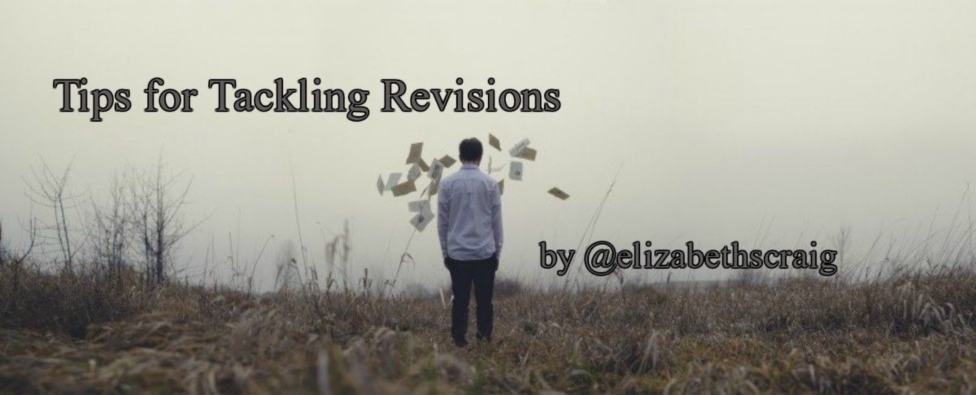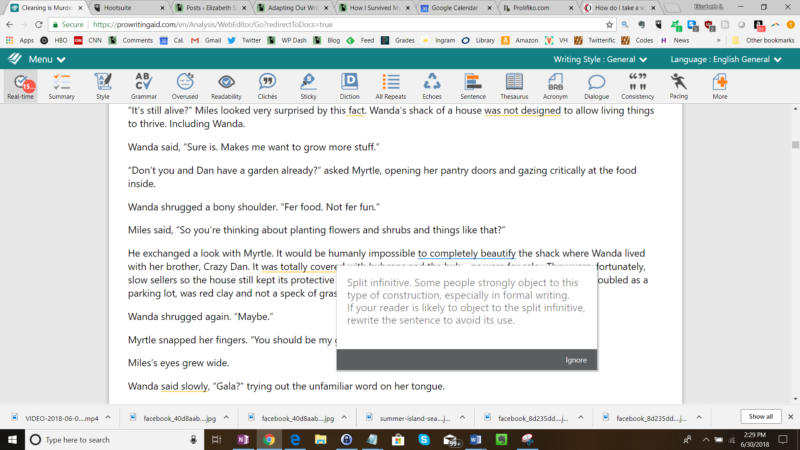by Elizabeth S. Craig, @elizabethscraig
When I finish writing a book, I follow a particular routine to get it into shape for publication. In case my process helps anyone else, I thought I’d share it here.
First off, I read the story through once and make small changes as I go. Small changes are typos as well as things like changing the age of a character or fixing an inconsistency. I note on a separate document (Things to Fix) larger changes that I’d like to make. In a recent book, these larger changes included: adding more scenes for a character, adding another suspect interview, following up on dialogue a character threw out in chapter two, and taking advantage of setting more.
Adding or Subtracting Scenes: This is the easiest type of revision work. As I go through, I make notes on possible changes. Then I usually write those changes in a separate doc (if they’re additional scenes or) and weave them in. It’s important to read the book through a few times to make sure that the additions and subtractions don’t mess up the timeline or create any other problems.
That’s followed by running the whole thing through editing software (I use ProWritingAid, shown below) and then submitting it to beta readers and my editor.
Changes Requested by a Beta Reader or Editor: When I get feedback or editorial comments from an editor… I think about them. Are they right for the story? I give myself a little time to wrap my head around the changes that are being requested. I know when I receive an email with a long list of ideas for revisions, it’s almost impossible to absorb it all right away. I always sleep on it and tackle it the next day. My initial reaction to the requested edits, which I keep to myself? It’s usually a very unprofessional, “Oh no. No, no. Please, no.” :)
The next day, I copy the email into Word and use track changes to brainstorm ways of incorporating the changes (if I make them). I also do this for smaller changes, with a simple ‘fixed’:
After I’m done noting how I’d manage the more complex revisions, I review them. What seems necessary? What improves the story? What seems like a lot of hassle for very little payoff? Is there another way to make those changes without the hassle?
For the bigger changes, I write the scenes in a separate doc in order and then weave them into the story as I read the book through again. Plus, I try to give myself a large block of time to do this: maybe 4 or 5 hours. That way, inconsistencies and timeline issues seem to jump off the page better for me (others recommend letting the book sit for a while and coming back to it, but this doesn’t work well for my schedule…I usually release a book a month after I finish drafting it).
Then I read the book through again another time or two.
A note on organizing all this. Now I do it all digitally. I didn’t in the past, but I had a tough time keeping all the bits together. Now I have a folder for my book and put everything related to that book in the folder. And back it up religiously.
This is what works for me, but I’m always interested in hearing what works well for other writers (sometimes I tweak what I’m doing). How do you handle small edits and larger revisions?
Tips for Tackling Edits and Revisions: Click To Tweet



The biggest difference with my process is I hand write all revisions and changes. Those from a critique partner that are small things I will change in the document, but I’ll print the whole thing out and make bigger changes there. (I only print one side so I have room on the opposite side of each page to add or change things.) Then I adjust the Word document. And print it out again for another pass or two or three.
I remember doing exactly what you did. I can’t remember when I stopped or exactly why, although I know I became better at working digitally. I think it was an organizational thing for me and keeping my docs all together. But many times I still believe that I *think* better on paper.
Hi Elizabeth – your process is relatively settled … you’ve been there and done it more than a few times and this must help a lot – the methodology is also there and you’ve learnt to keep it backed-up, with brief notations that would jog your memory, and so it’s as if it’s like driving … almost automatic. The other helpful thing for you is – that you’re ready for another book publication within a time frame already set up. It’s great you’re here to let us know your methods etc … thanks – always interesting – cheers Hilary
You’re so right–it’s very automatic. Muscle memory, practically. But since I’m writing book 31 now, it’s just the repetition of it all, ha. Hope you have a great weekend, Hilary!
Sounds like the editing software is a big help and definitely a resource writers could use. Anytime I write something I have to step away from it for a day and then come back with fresh eyes. Your process sounds very helpful.
The software does really help…it just eliminates dumb errors on my part before I waste my editor’s time with them!
Elizabeth, I didn’t think to ask but which software integration do you use with the ProWritingAid? Looks like it would be good to use with either Microsoft Word or Scrivener. Do you know if one works better than the other?
Honestly, I don’t even really integrate it, although you could. I pull it up in a browser window and copy-paste my text in there. I usually will do it a chapter at a time because my chapters are about 10 pages and it keeps the software from getting too overloaded at once.
I really like your ‘Things to Fix’ idea, Elizabeth. With something like that, you can focus on the draft you’re writing, and keep good track of what you know you’ll have to fix later without letting it bog you down. That makes a lot of sense to me. Thanks for sharing what you do.
It really does help to keep me focused on working my way through the draft. Otherwise, I think I’d be too distracted with all the upcoming edits.
Am at this stage currently on my first book–a memoir–so this is extremely helpful. Thanks!
So glad to help! Good luck with the memoir!
A month from draft to publication? :jawdrop: You and your editor work way faster than we do. I can’t imagine. But that’s why it always interesting to read about other writer’s processes. We all come at this differently.
Still, I’m a little jealous of your speed. ;o)
I think I’m a little spoiled, ha. Hopefully my editor won’t decide to retire anytime soon! It doesn’t take us long at all, but we’re in a rhythm with it now.
I still do a lot of this kind of editing during my first draft. Yes, I know some authors suggest waiting until you finish the first draft before tackling these kinds of things, but that seems like procrastination to me. And it’s not like I won’t still have to a lot of editing to do after I reach the end anyway. Might as well do what I can to fix up a scene while it’s still fresh in my mind.
Admittedly, there will come a point at which I simply can’t stare at a scene any longer and then I move on, confident in the knowledge that I will eventually come back to it with fresh eyes.
I think whatever works best for a writer is what they should stick with! I know another author who does it exactly as you’re saying and she does really well with her approach. :)
Interesting to have processes other writer’s use. I write in Scrivener which has so many ways to make notes/comments as you go along in revising or editing. Now ProWritingAid integrates with Scrivener so that is a help. Do you have recommendations for an editor? Thanks for sharing all that you do!
I’ve personally used Judy Beatty (she’s found via Facebook) and Zoe Nightingale (also found via Facebook).
For many more recommendations, I’d join the 20BooksTo50K Facebook group and search ‘editor’.
Reading my comment over, this is the reason why I can’t leave Facebook, ha (although I’ve been very tempted!)
Thanks for the names! I belong to that group and will search per your suggestion. Yes, FaceBook is of value! Digital advancements and social media platforms have their benefits.
I think that group is a great resource. And you’re so right about the benefits of social media!
I can’t imagine printing things out often – I’m terrible with paper – but very organized on the computer. I tend to be overwhelmed by the big changes and am still learning to tackle them effectively!
Printing worked great for me…until it didn’t suddenly! I think it was partially the clutter aspect (and maybe the ‘klutzy’ aspect as I’d drop papers and everything would end up out of order). I think everyone must find big changes overwhelming…it’s intimidating to see a list of possible revisions!
This is a very timely post for me because I sent my latest draft to my editor last night. Like you, I only have a month turnaround time from finishing my draft to publication.
I revise when I write, so I’m always cycling back to previous scenes to make changes for continuity. Scrivener makes this an easy process. I also have a spreadsheet that I use to outline my story as I write. I keep track of word counts, their percentage in the story, characters in a scene, the story beat, is the scene an action/reaction scene, etc. I also keep my revision punchlist in my spreadsheet.
My spreadsheet is my developmental editor. Lol! It gets me away from the words and think about the story logically to see how the scenes and the pacing fit together. I’m more of a headlights plotter. Basically, I only see what’s happening in the current scene I’m writing and the next two scenes or so. I usually have an ending in mind, so that’s where I’m driving the story. So far, with my spreadsheet, I haven’t toss out any scenes in the last 6 books.
In my second draft, I run my manuscript a scene at a time through ProWritingAid and Grammarly. I also go through my revision punchlist and add in description. Usually, it takes about 3 days for me to do the polish draft before shipping it to the editor.
When I get the manuscript back from my editor and a paid beta reader, I make the copyedits and then ship it to my beta team. My beta team are volunteer readers, and they comb through my manuscript for any typos that escape my editor. I love it when I get to this stage of my writing. It’s my first real feedback of the story. These ladies’ feedback makes the frantic last month of writing all worth it.
Absolutely fascinating! I really enjoy hearing about other writers’ approaches. It sounds as if you’ve honed your spreadsheet to make it an incredibly useful tool….not only for outlining, but to check for problems and stay on track with your story.
Like you, I find my betas so very helpful. I love hearing back from them.